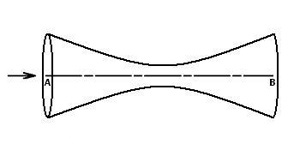...
| Wiki Markup |
|---|
{alias:nozzle}
{panel}
|
| Panel |
Author: Rajesh Bhaskaran, CornellUniversity Problem Specification |
Problem Specification
Consider air flowing at high-speed through a convergent-divergent nozzle having a circular cross-sectional area, A, that varies with axial distance from the throat, x, according to the formula
A = 0.1 + x2; -0.5 < x < 0.5
where A is in square meters and x is in meters. The stagnation pressure po at the inlet is 101,325 Pa. The stagnation temperature To at the inlet is 300 K. The static pressure p at the exit is 3,738.9 Pa. We will calculate the Mach number, pressure and temperature distribution in the nozzle using FLUENT and compare the solution to quasi-1D nozzle flow results. The Reynolds number for this high-speed flow is large. So we expect viscous effects to be confined to a small region close to the wall. So it is reasonable to model the flow as inviscid.
Go to Step 1: Create Geometry in GAMBIT
See and rate the complete Learning Module
University
{color:#cc0000}{*}Problem Specification{*}{color}
[1. Create Geometry in GAMBIT|FLUENT - Compressible Flow in a Nozzle- Step 1]
[2. Mesh Geometry in GAMBIT|FLUENT - Compressible Flow in a Nozzle- Step 2]
[3. Specify Boundary Types in GAMBIT|FLUENT - Compressible Flow in a Nozzle- Step 3]
[4. Set Up Problem in FLUENT|FLUENT - Compressible Flow in a Nozzle- Step 4]
[5. Solve\!|FLUENT - Compressible Flow in a Nozzle- Step 5]
[6. Analyze Results|FLUENT - Compressible Flow in a Nozzle- Step 6]
[7. Refine Mesh|FLUENT - Compressible Flow in a Nozzle- Step 7]
[Problem 1|FLUENT - Compressible Flow in a Nozzle- Problem 1]
[Problem 2|FLUENT - Compressible Flow in a Nozzle- Problem 2]
{panel}
h2. Problem Specification
!nozzle2.jpg!
Consider air flowing at high-speed through a convergent-divergent nozzle having a circular cross-sectional area, _A_, that varies with axial distance from the throat, _x_, according to the formula
A = 0.1 + x{^}2^; \-0.5 < x < 0.5
where _A_ is in square meters and _x_ is in meters. The stagnation pressure _p{_}{_}{~}o{~}_ at the inlet is 101,325 Pa. The stagnation temperature _T{_}{_}{~}o{~}_ at the inlet is 300 K. The static pressure _p_ at the exit is 3,738.9 Pa. We will calculate the Mach number, pressure and temperature distribution in the nozzle using FLUENT and compare the solution to quasi-1D nozzle flow results. The Reynolds number for this high-speed flow is large. So we expect viscous effects to be confined to a small region close to the wall. So it is reasonable to model the flow as inviscid.
Go to [Step 1: Create Geometry in GAMBIT|FLUENT - Compressible Flow in a Nozzle- Step 1]
[See and rate the complete Learning Module|FLUENT - Compressible Flow in a Nozzle]
[Go to all FLUENT Learning Modules|FLUENT Learning Modules] |
 Sign-up for free online course on ANSYS simulations!
Sign-up for free online course on ANSYS simulations!